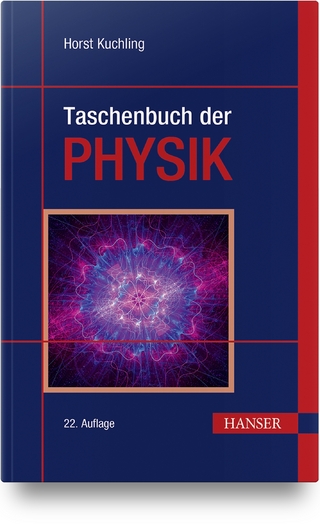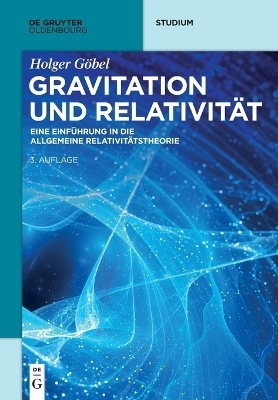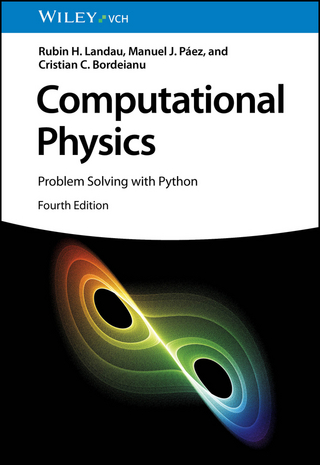
Physics for Scientists & Engineers with Modern Physics
Pearson (Verlag)
978-0-13-149508-1 (ISBN)
- Titel erscheint in neuer Auflage
- Artikel merken
This long-awaited and extensive revision maintains Giancoli's reputation for creating carefully crafted, highly accurate and precise physics texts. Physics for Scientists and Engineers combines outstanding pedagogy with a clear and direct narrative and applications that draw the student into the physics. The new edition also features an unrivaled suite of media and on-line resources that enhance the understanding of physics.
This book is written for students. It aims to explain physics in a readable and interesting manner that is accessible and clear, and to teach students by anticipating their needs and difficulties without oversimplifying.
Physics is a description of reality, and thus each topic begins with concrete observations and experiences that students can directly relate to. We then move on to the generalizations and more formal treatment of the topic. Not only does this make the material more interesting and easier to understand, but it is closer to the way physics is actually practiced.
CONTENTS OF VOLUME 1
APPLICATIONS LIST xii
PREFACE xiv
AVAILABLE SUPPLEMENTS AND MEDIA xxii
NOTES TO STUDENTS (AND INSTRUCTORS) ON THE FORMAT xxiv
COLOR USE: VECTORS, FIELDS, AND SYMBOLS xxv
CHAPTER1: INTRODUCTION, MEASUREMENT, ESTIMATING
1—1 The Nature of Science
1—2 Models, Theories, and Laws
1—3 Measurement and Uncertainty; Significant Figures
1—4 Units, Standards, and the SI System
1—5 Converting Units
1—6 Order of Magnitude: Rapid Estimating
*1—7 Dimensions and Dimensional Analysis
SUMMARY
QUESTIONS
PROBLEMS
GENERAL PROBLEMS
CHAPTER 2: DESCRIBING MOTION: KINEMATICS IN ONE DIMENSION
2—1 Reference Frames and Displacement
2—2 Average Velocity
2—3 Instantaneous Velocity
2—4 Acceleration
2—5 Motion at Constant Acceleration
2—6 Solving Problems
2—7 Freely Falling Objects
*2—8 Variable Acceleration; Integral Calculus
*2—9 Graphical Analysis and Numerical Integration
SUMMARY
QUESTIONS
PROBLEMS
GENERAL PROBLEMS
CHAPTER 3: KINEMATICS IN TWO OR THREE DIMENSIONS; VECTORS
3—1 Vectors and Scalars
3—2 Addition of Vectors–Graphical Methods
3—3 Subtraction of Vectors, and Multiplication of a Vector by a Scalar
3—4 Adding Vectors by Components
3—5 Unit Vectors
3—6 Vector Kinematics
3—7 Projectile Motion
3—8 Solving Problems Involving Projectile Motion
3—9 Relative Velocity
SUMMARY
QUESTIONS
PROBLEMS
GENERAL PROBLEMS
CHAPTER 4: DYNAMICS: NEWTON’S LAWS OF MOTION
4—1 Force
4—2 Newton’s First Law of Motion
4—3 Mass
4—4 Newton’s Second Law of Motion
4—5 Newton’s Third Law of Motion
4—6 Weight–the Force of Gravity; and the Normal Force
4—7 Solving Problems with Newton’s Laws: Free-Body Diagrams
4—8 Problem Solving–A General Approach
SUMMARY
QUESTIONS
PROBLEMS
GENERAL PROBLEMS
CHAPTER 5: USING NEWTON’S LAWS: FRICTION, CIRCULAR MOTION, DRAG FORCES
5—1 Applications of Newton’s Laws Involving Friction
5—2 Uniform Circular Motion–Kinematics
5—3 Dynamics of Uniform Circular Motion
5—4 Highway Curves: Banked and Unbanked
*5—5 Nonuniform Circular Motion
*5—6 Velocity-Dependent Forces: Drag and Terminal Velocity
SUMMARY
QUESTIONS
PROBLEMS
GENERAL PROBLEMS
CHAPTER 6: GRAVITATION AND NEWTON’S6 SYNTHESIS
6—1 Newton’s Law of Universal Gravitation
6—2 Vector Form of Newton’s Law of Universal Gravitation
6—3 Gravity Near the Earth’s Surface; Geophysical Applications
6—4 Satellites and “Weightlessness”
6—5 Kepler’s Laws and Newton’s Synthesis
*6—6 Gravitational Field
6—7 Types of Forces in Nature
*6—8 Principle of Equivalence; Curvature of Space; Black Holes
SUMMARY
QUESTIONS
PROBLEMS
GENERAL PROBLEMS
CHAPTER 7: WORK AND ENERGY
7—1 Work Done by a Constant Force
7—2 Scalar Product of Two Vectors
7—3 Work Done by a Varying Force
7—4 Kinetic Energy and the Work-Energy Principle
SUMMARY
QUESTIONS
PROBLEMS
GENERAL PROBLEMS
CHAPTER 8: CONSERVATION OF ENERGY
8—1 Conservative and Nonconservative Forces
8—2 Potential Energy
8—3 Mechanical Energy and Its Conservation
8—4 Problem Solving Using Conservation of Mechanical Energy
8—5 The Law of Conservation of Energy
8—6 Energy Conservation with Dissipative Forces: Solving Problems
8—7 Gravitational Potential Energy and Escape Velocity
8—8 Power
*8—9 Potential Energy Diagrams; Stable and Unstable Equilibrium
SUMMARY
QUESTIONS
PROBLEMS
GENERAL PROBLEMS
CHAPTER 9: LINEAR MOMENTUM
9—1 Momentum and Its Relation to Force
9—2 Conservation of Momentum
9—3 Collisions and Impulse
9—4 Conservation of Energy and Momentum in Collisions
9—5 Elastic Collisions in One Dimension
9—6 Inelastic Collisions
9—7 Collisions in Two or Three Dimensions
9—8 Center of Mass (CM)
9—9 Center of Mass and Translational Motion
*9—10 Systems of Variable Mass; Rocket Propulsion
SUMMARY
QUESTIONS
PROBLEMS
GENERAL PROBLEMS
CHAPTER 10: ROTATIONAL MOTION
10—1 Angular Quantities
10—2 Vector Nature of Angular Quantities
10—3 Constant Angular Acceleration
10—4 Torque
10—5 Rotational Dynamics; Torque and Rotational Inertia
10—6 Solving Problems in Rotational Dynamics
10—7 Determining Moments of Inertia
10—8 Rotational Kinetic Energy
10—9 Rotational Plus Translational Motion; Rolling
*10—10 Why Does a Rolling Sphere Slow Down?
SUMMARY
QUESTIONS
PROBLEMS
GENERAL PROBLEMS
CHAPTER 11: ANGULAR MOMENTUM; GENERAL ROTATION
11—1 Angular Momentum–Object Rotating About a Fixed Axis
11—2 Vector Cross Product; Torque as a Vector
11—3 Angular Momentum of a Particle
11—4 Angular Momentum and Torque for a System of Particles; General Motion
11—5 Angular Momentum and Torque for a Rigid Object
11—6 Conservation of Angular Momentum
*11—7 The Spinning Top and Gyroscope
*11—8 Rotating Frames of Reference; Inertial Forces
*11—9 The Coriolis Effect
SUMMARY
QUESTIONS
PROBLEMS
GENERAL PROBLEMS
CHAPTER 12: STATIC EQUILIBRIUM; ELASTICITY AND FRACTURE
12—1 The Conditions for Equilibrium
12—2 Solving Statics Problems
12—3 Stability and Balance
12—4 Elasticity; Stress and Strain
12—5 Fracture
*12—6 Trusses and Bridges
*12—7 Arches and Domes
SUMMARY
QUESTIONS
PROBLEMS
GENERAL PROBLEMS
CHAPTER 13: FLUIDS
13—1 Phases of Matter
13—2 Density and Specific Gravity
13—3 Pressure in Fluids
13—4 Atmospheric Pressure and Gauge Pressure
13—5 Pascal’s Principle
13—6 Measurement of Pressure; Gauges and the Barometer
13—7 Buoyancy and Archimedes’ Principle
13—8 Fluids in Motion; Flow Rate and the Equation of Continuity
13—9 Bernoulli’s Equation
13—10 Applications of Bernoulli’s Principle: Torricelli, Airplanes, Baseballs, TIA
*13—11 Viscosity
*13—12 Flow in Tubes: Poiseuille’s Equation, Blood Flow
*13—13 Surface Tension and Capillarity
*13—14 Pumps, and the Heart
SUMMARY
QUESTIONS
PROBLEMS
GENERAL PROBLEMS
CHAPTER 14: OSCILLATIONS
14—1 Oscillations of a Spring
14—2 Simple Harmonic Motion
14—3 Energy in the Simple Harmonic Oscillator
14—4 Simple Harmonic Motion Related to Uniform Circular Motion
14—5 The Simple Pendulum
*14—6 The Physical Pendulum and the Torsion Pendulum
14—7 Damped Harmonic Motion
14—8 Forced Oscillations; Resonance
SUMMARY
QUESTIONS
PROBLEMS
GENERAL PROBLEMS
CHAPTER 15: WAVE MOTION
15—1 Characteristics of Wave Motion
15—2 Types of Waves: Transverse and Longitudinal
15—3 Energy Transported by Waves
15—4 Mathematical Representation of a Traveling Wave
*15—5 The Wave Equation
15—6 The Principle of Superposition
15—7 Reflection and Transmission
15—8 Interference
15—9 Standing Waves; Resonance
*15—10 Refraction
*15—11 Diffraction
SUMMARY
QUESTIONS
PROBLEMS
GENERAL PROBLEMS
CHAPTER 16: SOUND
16—1 Characteristics of Sound
16—2 Mathematical Representation of Longitudinal Waves
16—3 Intensity of Sound: Decibels
16—4 Sources of Sound: Vibrating Strings and Air Columns
*16—5 Quality of Sound, and Noise; Superposition
16—6 Interference of Sound Waves; Beats
16—7 Doppler Effect
*16—8 Shock Waves and the Sonic Boom
*16—9 Applications: Sonar, Ultrasound, and Medical Imaging
SUMMARY
QUESTIONS
PROBLEMS
GENERAL PROBLEMS
CHAPTER 17: TEMPERATURE, THERMAL EXPANSION, AND THE IDEAL GAS LAW
17—1 Atomic Theory of Matter
17—2 Temperature and Thermometers
17—3 Thermal Equilibrium and the Zeroth Law of Thermodynamics
17—4 Thermal Expansion
*17—5 Thermal Stresses
17—6 The Gas Laws and Absolute Temperature
17—7 The Ideal Gas Law
17—8 Problem Solving with the Ideal Gas Law
17—9 Ideal Gas Law in Terms of Molecules: Avogadro’s Number
*17—10 Ideal Gas Temperature Scale–a Standard
SUMMARY
QUESTIONS
PROBLEMS
GENERAL PROBLEMS
CHAPTER 18: KINETIC THEORY OF GASES
18—1 The Ideal Gas Law and the Molecular Interpretation of Temperature
18—2 Distribution of Molecular Speeds
18—3 Real Gases and Changes of Phase
18—4 Vapor Pressure and Humidity
*18—5 Van der Waals Equation of State
*18—6 Mean Free Path
*18—7 Diffusion
SUMMARY
QUESTIONS
PROBLEMS
GENERAL PROBLEMS
CHAPTER 19: HEAT AND THE FIRST LAW OF THERMODYNAMICS
19—1 Heat as Energy Transfer
19—2 Internal Energy
19—3 Specific Heat
19—4 Calorimetry–Solving Problems
19—5 Latent Heat
19—6 The First Law of Thermodynamics
19—7 Applying the First Law of Thermodynamics; Calculating the Work
19—8 Molar Specific Heats for Gases, and the Equipartition of Energy
19—9 Adiabatic Expansion of a Gas
19—10 Heat Transfer: Conduction, Convection, Radiation
SUMMARY
QUESTIONS
PROBLEMS
GENERAL PROBLEMS
CHAPTER 20: SECOND LAW OF THERMODYNAMICS
20—1 The Second Law of Thermodynamics–Introduction
20—2 Heat Engines
20—3 Reversible and Irreversible Processes; the Carnot Engine
20—4 Refrigerators, Air Conditioners, and Heat Pumps
20—5 Entropy
20—6 Entropy and the Second Law of Thermodynamics
20—7 Order to Disorder
20—8 Unavailability of Energy; Heat Death
*20—9 Statistical Interpretation of Entropy and the Second Law
*20—10 Thermodynamic Temperature Scale; Absolute Zero and the Third Law of Thermodynamics
*20—11 Thermal Pollution, Global Warming, and Energy Resources
SUMMARY
QUESTIONS
PROBLEMS
GENERAL PROBLEMS
CHAPTER 21: ELECTRIC CHARGE AND ELECTRIC FIELD
21—1 Static Electricity; Electric Charge and Its Conservation
21—2 Electric Charge in the Atom
21—3 Insulators and Conductors
21—4 Induced Charge; the Electroscope
21—5 Coulomb’s Law
21—6 The Electric Field
21—7 Electric Field Calculations for Continuous Charge Distributions
21—8 Field Lines
21—9 Electric Fields and Conductors
21—10 Motion of a Charged Particle in an Electric Field
21—11 Electric Dipoles
*21—12 Electric Forces in Molecular Biology; DNA
*21—13 Photocopy Machines and Computer Printers Use Electrostatics
SUMMARY
QUESTIONS
PROBLEMS
GENERAL PROBLEMS
CHAPTER 22: GAUSS’S LAW
22—1 Electric Flux
22—2 Gauss’s Law
22—3 Applications of Gauss’s Law
*22—4 Experimental Basis of Gauss’s and Coulomb’s Law
SUMMARY
QUESTIONS
PROBLEMS
GENERAL PROBLEMS
CHAPTER 23: ELECTRIC POTENTIAL
23—1 Electric Potential Energy and Potential Difference
23—2 Relation between Electric Potential and Electric Field
23—3 Electric Potential Due to Point Charges
23—4 Potential Due to Any Charge Distribution
23—5 Equipotential Surfaces
23—6 Electric Dipole Potential
23—7 E Determined from V
23—8 Electrostatic Potential Energy; the Electron Volt
23—9 Cathode Ray Tube: TV and Computer Monitors, Oscilloscope
SUMMARY
QUESTIONS
PROBLEMS
GENERAL PROBLEMS
CHAPTER 24: CAPACITANCE, DIELECTRICS, ELECTRIC ENERGY STORAGE
24—1 Capacitors
24—2 Determination of Capacitance
24—3 Capacitors in Series and Parallel
24—4 Electric Energy Storage
24—5 Dielectrics
*24—6 Molecular Description of Dielectrics
SUMMARY
QUESTIONS
PROBLEMS
GENERAL PROBLEMS
CHAPTER 25: ELECTRIC CURRENTS AND RESISTANCE
25—1 The Electric Battery
25—2 Electric Current
25—3 Ohm’s Law: Resistance and Resistors
25—4 Resistivity
25—5 Electric Power
25—6 Power in Household Circuits
25—7 Alternating Current
25—8 Microscopic View of Electric Current: Current Density and Drift Velocity
*25—9 Superconductivity
*25—10 Electrical Conduction in the Nervous System
SUMMARY
QUESTIONS
PROBLEMS
GENERAL PROBLEMS
CHAPTER 26: DC CIRCUITS
26-1 EMF and Terminal Voltage
26-2 Resistors in Series and in Parallel
26-3 Kirchoff’s Rules
26-4 EMFs in Series and in Parallel; Charging a Battery
26-5 Circuits Containing Resistor and Capacitor (RC Circuits)
26-6 Electric Hazards
*26-7 Ammeters and Voltmeters
SUMMARY
QUESTIONS
PROBLEMS
GENERAL PROBLEMS
CHAPTER 27: MAGNETISM
27-1 Magnets and Magnetic Fields
27-2 Electric Currents Produce Magnetic Fields
27-3 Force on an Electric Current in a Magnetic Field; Definition of
27-4 Force on an Electric Charge Moving in a Magnetic Field
27-5 Torque on a Current Loop; Magnetic Dipole Moment
*27-6 Applications: Galvanometers, Motors, Loudspeakers
27-7 Discover and Properties of the Electron
*27-8 The Hall Effect
*27-9 Mass Spectrometer
SUMMARY
QUESTIONS
PROBLEMS
GENERAL PROBLEMS
CHAPTER 28: SOURCES OF MAGNETIC FIELD
28-1 Magnetic Field Due to a Straight Wire
28-2 Force between Two Parallel Wires
28-3 Definitions of the Ampere and the Coulomb
28-4 Ampere’s Law
28-5 Magnetic Field of a Solenoid and a Toroid
28-6 Biot-Savart Law
*28-7 Magnetic materials–Ferromagnetism
*28-8 Electromagnets and Solenoids—Applications
*28-9 Magnetic Fields in Magnetic Materials; Hysteresis
*28-10 Paramagnetism and Diamagnetism
SUMMARY
QUESTIONS
PROBLEMS
GENERAL PROBLEMS
CHAPTER 29: ELECTROMAGNETIC INDUCTION AND FARADAY’S LAW
29-1 Induced EMF
29-2 Faraday’s Law of Induction; Lenz’s Law
29-3 EMF Induced in a Moving Conductor
29-4 Electric Generators
*29-5 Back EMF and Counter Torque; Eddy Currents
29-6 Transformers and Transmission of Power
29-7 A Changing Magnetic Flux Produces an Electric Field
*29-8 Applications of Induction: Sound Systems, Computer Memory, Seismograph, GFCI
SUMMARY
QUESTIONS
PROBLEMS
GENERAL PROBLEMS
CHAPTER 30: INDUCTANCE, ELECTROMAGNETIC OSCILLATIONS, AND AC CIRCUITS
30-1 Mutual Inductance
30-2 Self-Inductance
30-3 Energy Stored in a Magnetic Field
30-4 LR Circuits
30-5 LC Circuits and Electromagnetic Oscillations
30-6 LC Oscillations with Resistance (LRC Circuit)
30-7 AC Circuits with AC Source
30-8 LRC Series AC Circuit
30-9 Resonance in AC Circuits
*30-10 Impedance Matching
SUMMARY
QUESTIONS
PROBLEMS
GENERAL PROBLEMS
CHAPTER 31: MAXWELL’S EQUATIONS AND ELECTROMAGNETIC WAVES
31-1 Changing Electric Fields Produce Magnetic Fields; Ampere’s Law and Displacement Current
31-2 Gauss’s Law for Magnetism
31-3 Maxwell’s Equations
31-4 Production of Electromagnetic Waves
*31-5 Electromagnetic Waves, and Their Speed, from Maxwell’s Equations
31-6 Light as an Electromagnetic Wave and the Electromagnetic Spectrum
31-7 Measuring the Speed of Light
31-8 Energy in EM Waves; the Poynting Vector
*31-9 Radiation Pressure
*31-10 Radio and Television; Wireless Communication
SUMMARY
QUESTIONS
PROBLEMS
GENERAL PROBLEMS
CHAPTER 32: LIGHT: REFLECTION AND REFRACTION
32-1 The Ray Model of Light
32-2 The Speed of Light and Index of Refraction
32-3 Reflection; Image Formation by a Plane Mirror
32-4 Formation of Images by Spherical Mirrors
32-5 Refraction: Snell’s Law
32-6 Visible Spectrum and Dispersion
32-7 Total Internal Reflection; Fiber Optics
*32-8 Refraction at a Spherical Surface
SUMMARY
QUESTIONS
PROBLEMS
GENERAL PROBLEMS
CHAPTER 33: LENSES AND OPTICAL INSTRUMENTS
33-1 Thin Lenses; Ray Tracing
33-2 The Thin Lens Equation; Magnification
33-3 Combinations of Lenses
33-4 Lensmaker’s Equation
33-5 Cameras, Film and Digital
33-6 The Human Eye; Corrective Lenses
33-7 Magnifying Glass
33-8 Telescopes
*33-9 Compound Microscope
*33-10 Aberrations of Lenses and Mirrors
SUMMARY
QUESTIONS
PROBLEMS
GENERAL PROBLEMS
CHAPTER 34: THE WAVE NATURE OF LIGHT; INTERFERENCE
34-1 Waves Versus Particles; Huygens’ Principle and Diffraction
34-2 Huygens’ Principle and the Law of Refraction
34-3 Interference–Young’s Double-Slit Experiment
34-4 Intensity in the Double-Slit Interference Pattern
34-5 Interference in Thin Films
*34-6 Michelson Interferometer
*34-7 Luminous Intensity
SUMMARY
QUESTIONS
PROBLEMS
GENERAL PROBLEMS
CHAPTER 35: DIFFRACTION AND POLARIZATION
35-1 Diffraction by a Single Slit or Disk
35-2 Intensity in Single-Slit Diffraction Pattern
35-3 Diffraction in the Double-Slit Experiment
35-4 Limits of Resolution; Circular Apertures
35-5 Resolution of Telescopes and Microscopes; the λ Limit
*35-6 Resolution of the Human Eye and Useful Magnification
35-7 Diffraction Grating
*35-8 The Spectrometer and Spectroscopy
*35-9 Peak Widths and Resolving Power for a Diffraction Grating
*35-10 X-Rays and X-Ray Diffraction
35-11 Polarization
*35-12 Liquid Crystal Displays (LCD)
*35-13 Scattering of Light by the Atmosphere
SUMMARY
QUESTIONS
PROBLEMS
GENERAL PROBLEMS
CHAPTER 36: SPECIAL THEORY OF RELATIVITY
36-1 Galilean—Newtonian Relativity
*36-2 The Michelson-Morley Experiment
36-3 Postulates of the Special Theory of Relativity
36-4 Simultaneity
36-5 Time Dilation and the Twin Paradox
36-6 Length Contraction
36-7 Four-Dimensional Space-Time
36-8 Galilean and Lorentz Transformations
36-9 Relativistic Momentum and Mass
36-10 The Ultimate Speed
36-11 Energy and Mass; E=mc2
36-12 Doppler Shift for Light
36-13 The Impact of Special Relativity
SUMMARY
QUESTIONS
PROBLEMS
GENERAL PROBLEMS
CHAPTER 37: EARLY QUANTUM THEORY AND MODELS OF THE ATOM
37-1 Planck’s Quantum Hypothesis
37-2 Photon Theory of Light and the Photoelectric Effect
37-3 Photons and the Compton Effect
37-4 Photon Interactions; Pair Production
37-5 Wave-Particle Duality; the Principle of Complementarity
37-6 Wave Nature of Matter
*37-7 Electron Microscopes
37-8 Early Models of the Atom
37-9 Atomic Spectra: Key to the Structure of the Atom
37-10 The Bohr Model
37-11 DeBroglie’s Hypothesis Applied to Atoms
SUMMARY
QUESTIONS
PROBLEMS
GENERAL PROBLEMS
CHAPTER 38: QUANTUM MECHANICS
38-1 Quantum Mechanics–A New Theory
38-2 The Wave Function and Its Interpretation; the Double-Slit Experiment
38-3 The Heisenberg Uncertainty Principle
38-4 Philosophic Implications; Probability Versus Determinism
38-5 The Schrodinger Equation in One Dimension–Time-Independent Form
*38-6 Time-Dependent Schrodinger Equation
38-7 Free Particles; Plane Waves and Wave Packets
38-8 Particle in an Infinitely Deep Square Well Potential (a Rigid Box)
*38-9 Finite Potential Well
38-10 Tunneling through a Barrier
SUMMARY
QUESTIONS
PROBLEMS
GENERAL PROBLEMS
CHAPTER 39: QUANTUM MECHANICS OF ATOMS
39-1 Quantum-Mechanical View of Atoms
39-2 Hydrogen Atom: Schrodinger Equation and Quantum Numbers
39-3 Hydrogen Atom Wave Functions
39-4 Complex Atoms; the Exclusion Principle
39-5 The Periodic Table of Elements
39-6 X-Ray Spectra and Atomic Number
*39-7 Magnetic Dipole Moments; Total Angular Momentum
*39-8 Fluorescence and Phosphorescence
*39-9 Lasers
*39-10 Holography
SUMMARY
QUESTIONS
PROBLEMS
GENERAL PROBLEMS
CHAPTER 40: MOLECULES AND SOLIDS
40-1 Bonding in Molecules
40-2 Potential-Energy Diagrams for Molecules
40-3 Weak (van der Waals) Bonds
40-4 Molecular Spectra
40-5 Bonding in Solids
40-6 Free-Electron Theory of Metals
40-7 Band Theory of Solids
40-8 Semiconductors and Doping
*40-9 Semiconductor Diodes
*40-10 Transistors and Integrated Circuits
SUMMARY
QUESTIONS
PROBLEMS
GENERAL PROBLEMS
CHAPTER 41: NUCLEAR PHYSICS AND RADIOACTIVITY
41-1 Structure and Properties of the Nucleus
41-2 Binding Energy and Nuclear Forces
41-3 Radioactivity
41-4 Alpha Decay
41-5 Beta Decay
41-6 Gamma Decay
41-7 Conservation of Nucleon Number and Other Conservation Laws
41-8 Half-Life and Rate of Decay
41-9 Decay Series
41-10 Radioactive Dating
41-11 Detection of Radiation
SUMMARY
QUESTIONS
PROBLEMS
GENERAL PROBLEMS
CHAPTER 42: NUCLEAR ENERGY: EFECTS AND USES OF RADIATION
42-1 Nuclear Reactions and the Transmutations of Elements
42-2 Cross Section
42-3 Nuclear Fission; Nuclear Reactors
42-4 Fusion
42-5 Passage of radiation through matter; Radiation Damage
42-6 Measurement of Radiation–Dosimetry
*42-7 Radiation Therapy
*42-8 Tracers
*42-9 Imaging by Tomography: CAT Scans, and Emission Tomography
*42-10 Nuclear Magnetic Resonance (NMR) and Magnetic Resonance Imaging (MRI)
SUMMARY
QUESTIONS
PROBLEMS
GENERAL PROBLEMS
CHAPTER 43: ELEMENTARY PARTICLES
43-1 High-Energy Particles
43-2 Particle Accelerators and Detectors
43-3 Beginnings of Elementary Particle Physics—Particle Exchange
43-4 Particles and Antiparticles
43-5 Particle Interactions and Conservation Laws
43-6 Particle Classification
43-7 Particle Stability and Resonances
43-8 Strange Particles
43-9 Quarks
43-10 The “Standard Model”: Quantum Chromodynamics (QCD) and the Electroweak Theory
43-11 Grand Unified Theories
SUMMARY
QUESTIONS
PROBLEMS
GENERAL PROBLEMS
CHAPTER 44: ASTROPHYSICS AND COSMOLOGY
44-1 Stars and Galaxies
44-2 Stellar Evolution; the Birth and Death of Stars
44-3 General Relativity: Gravity and the Curvature of Space
44-4 The Expanding Universe
44-5 The Big Bang and the Cosmic Microwave Background
44-6 The Standard Cosmological Model: Early History of the Universe
44-7 The Future of the Universe?
SUMMARY
QUESTIONS
PROBLEMS
GENERAL PROBLEMS
| Erscheint lt. Verlag | 12.9.2008 |
|---|---|
| Sprache | englisch |
| Maße | 100 x 100 mm |
| Gewicht | 100 g |
| Themenwelt | Naturwissenschaften ► Physik / Astronomie |
| ISBN-10 | 0-13-149508-9 / 0131495089 |
| ISBN-13 | 978-0-13-149508-1 / 9780131495081 |
| Zustand | Neuware |
| Informationen gemäß Produktsicherheitsverordnung (GPSR) | |
| Haben Sie eine Frage zum Produkt? |
aus dem Bereich


